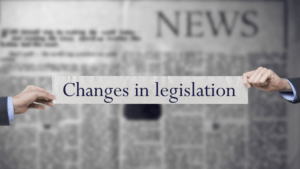The 2025 labor law changes will impact your business operations substantially. 80% of jurisdictions plan to raise their minimum wage to $15 per hour or above.
Federal guidelines on harassment and state-level requirements for pay transparency have altered the employment map. Nine states and seven jurisdictions now require pay transparency. More states like Illinois, Massachusetts, Minnesota, New Jersey, and Vermont will adopt similar measures in 2025.
This detailed guide explains the key updates in employment law that help you understand and implement changes to protect your business. You will learn about important deadlines, policy requirements, and practical steps to maintain compliance with federal and state regulations.
Key Employment Law Updates for 2025
The Department of Labor will roll out major changes to overtime exemption thresholds. The standard salary level for exempt employees will increase to $1,128 per week ($58,656 annually) starting January 1, 2025. The highly compensated employee threshold will also rise to $151,164 annually [1].
Federal labor law changes
The DOL has updated its guidance on independent contractor classification under the Fair Labor Standards Act. The new rule has six key factors that determine worker status. These factors cover the chance for profit or loss, financial stake, and degree of control [2].
State-level employment law modifications
Several states have introduced groundbreaking employment law changes. Here are the most influential changes:
- California has expanded whistleblower protections and has new requirements for social compliance audits [3]
- Illinois now requires employers with 15+ employees to include pay scales in job postings [4]
- Delaware’s paid family and medical leave program begins collecting employer contributions [3]
Critical compliance deadlines
Your 2025 compliance timeline has these key dates:
- January 1: Review state minimum wage rates and tax limits
- January 31: Distribute W-2 and 1095-C forms to employees
- February 28: File employer-provided health insurance coverage documentation
- April 30: Complete OSHA Form 300A posting period [5]
Companies operating in multiple states need to watch different implementation dates carefully. Massachusetts’ pay transparency requirements take effect on October 29, 2025. New Jersey’s similar law starts June 1, 2025 [6].
Creating a Compliance Implementation Plan
A good compliance strategy starts with a step-by-step approach to implement new labor law requirements. Of course, this process needs careful attention to detail and proper documentation.
Assessing your current policies
Your first step is a detailed review of your existing policies. Your assessment should look at:
- Pay transparency documentation
- Whistleblower protection protocols
- Employment verification practices [7]
- Social compliance audit procedures
- Benefits and compensation descriptions
- Paid time off policies [7]
Developing updated documentation
So, you need to keep detailed records of your compliance efforts. Your key documents should include employee pay stubs for at least three years after payment [8]. You must produce requested documents within seven working days [8].
Your documentation needs to focus on updating employee handbooks and internal policies that match new state and local requirements [9]. Note that you should add clear guidelines about quota requirements for warehouse employees. Each worker should get written documentation of their expectations [3].
Training requirements and schedules
A well-laid-out training program helps proper implementation. The Department of Labor has these resources:
- Online compliance seminars for contractors and stakeholders [10]
- Interactive FirstStep Employment Law Advisor tools
- Job Accommodation Network (JAN) services
- Toll-free assistance through the National Call Center [11]
You must give detailed training programs to all employees about their rights, obligations, and what happens if they don’t comply [12]. Regular updates through newsletters, intranet portals, and team meetings help keep your workforce informed about changing labor laws [12].
Make sure your training programs meet specific state certifications, especially for supervisors [13]. On top of that, keep records of all training sessions and when participants complete them to show your steadfast dedication to compliance.
Essential Policy Updates for Businesses
Your business needs to update three key policy areas that will affect operations in 2025. These changes need your attention now to comply with new regulations.
Pay transparency and wage requirements
The size of your workforce determines how you need to adapt to new pay transparency rules:
- 15+ employees: Include pay scale and benefits in all job postings [3]
- 30+ employees: Provide starting salary range with minimum and maximum amounts [3]
- 25+ employees: Disclose pay ranges for promotions and transfers [14]
Leave policies and accommodations
New regulations have changed how you should structure your leave policies. The updated rules state that employees no longer need to use vacation time before their paid family leave benefits [3]. Employees can now file disability insurance and paid family leave claims up to 30 days before their first compensable day [3].
Your accommodation policies must now include protection for domestic violence victims. The law requires you to provide reasonable safety measures when violence affects an employee or their family member [3].
Workplace safety regulations
New standards require major updates to your workplace safety protocols. The California Occupational Safety and Health Administration (CalOSHA) requires you to:
- Include Narcan in first aid kits [3]
- Implement weapons detection screening policies in hospitals [3]
- Create complete heat illness prevention plans for indoor temperatures reaching 82 degrees [15]
These safety measures protect your workforce from new workplace hazards. You should update your emergency procedures and train staff on all safety equipment.
Implementation Strategies and Best Practices
A systematic approach to documentation and communication is crucial for implementing new labor laws. Your organization needs specific guidelines to ensure complete compliance.
Step-by-step compliance checklist
- Review current personnel records retention practices
- Update employee handbooks and policy documents
- Establish clear timekeeping procedures
- Create documentation storage systems
- Schedule regular compliance audits
Keep in mind that all personnel records must be kept for at least one year [16]. Payroll records need a three-year retention period [16]. For EEOC charges, all related documentation must be preserved until the case reaches its final disposition [16].
Employee communication guidelines
Your communication strategy should cover:
- Clear explanations of changes and effective dates
- Effect statements for affected employees
- Designated contact person for questions
- Training schedules and requirements
- Regular updates through multiple channels
Transparency in your messaging about policy changes is vital. Town hall meetings or training sessions can help you deal with employee concerns directly [1].
Documentation and record-keeping procedures
Federal regulations mandate specific employee information in your record-keeping system. Everything in these records includes:
- Employee’s full name and social security number
- Address and birth date (if under 19)
- Time and day when workweek begins
- Hours worked each day and week
- Basis for wage payments
- Regular hourly pay rates [2]
These records should be available at your workplace or in a central records office. They must be ready for inspection within 72 hours of notice [17]. All benefit plan documentation needs to be kept while the plan stays active, plus one additional year [16].
Conclusion
Business owners need to pay attention to labor law changes coming in 2025. These updates bring major transformations, particularly with new minimum wage requirements and expanded pay transparency laws that affect businesses of all sizes across states.
Your business needs protection through a step-by-step approach. Review your policies thoroughly, get your documentation systems up to date, and create clear ways to communicate with employees. Note that good record-keeping will be your best defense against compliance problems.
Managing time well helps you meet various deadlines throughout the year. Minimum wage updates kick in during January, while other requirements roll out gradually across states. This gives you room to handle changes one at a time instead of all at once.
Being proactive about these regulatory changes determines your success. Quarterly compliance reviews help catch problems early. These new requirements might look daunting at first, but breaking them into smaller tasks makes the transition easier and keeps your business from getting hit with pricey violations.
References
[1] – https://www.apluspayroll.com/do-we-need-to-tell-employees-when-employment-laws-change/
[2] – https://www.dol.gov/agencies/whd/fact-sheets/21-flsa-recordkeeping
[3] – https://www.littler.com/publication-press/publication/employment-law-update-new-laws-2025
[4] – https://www.thehortongroup.com/resources/state-employment-laws-becoming-effective-january-1-2025/
[5] – https://hirelevel.com/2024/12/23/2025-compliance-calendar-hr-deadlines-for-employers/
[6] – https://www.bakerdonelson.com/ensuring-compliance-with-pay-transparency-laws-in-2025
[7] – https://www.amundsendavislaw.com/labor-employment-law-update/new-state-labor-and-employment-laws-impacting-employers-nationwide-to-take-effect-on-january-1-2025
[8] – https://knowledge.dlapiper.com/dlapiperknowledge/globalemploymentlatestdevelopments/2024/new-laws-for-illinois-employers-to-know-in-2025-and-beyond
[9] – https://gouldratner.com/publication/new-illinois-laws-in-2025-what-employers-need-to-know
[10] – https://www.dol.gov/newsroom/releases/whd/whd20241015-0
[11] – https://www.dol.gov/agencies/odep/publications/fact-sheets/employment-laws-overview-and-resources-for-employers
[12] – https://www.boomandbucket.com/blog/implementing-construction-labor-laws–regulations?srsltid=AfmBOooaofY4JwFEcPaGyfbS3XHHroS5xBGYm-Aj–OoZpcZhFHIOOcT
[13] – https://www.masoomlaw.com/es/news/preparing-for-changes-in-employment-law-in-2025
[14] – https://www.forbes.com/sites/alonzomartinez/2024/11/22/new-2025-pay-transparency-laws-what-employers-need-to-know/
[15] – https://www.coxcastle.com/publication-new-employment-laws-and-requirements-for-2025
[16] – https://www.eeoc.gov/employers/recordkeeping-requirements
[17] – https://www.wolterskluwer.com/en/expert-insights/wage-and-hour-recordkeeping-requirements









![What Does an HR Consultant Do? An Expert Guide for Business Owners [2025]](https://gamedayhr.com/wp-content/uploads/2025/01/drewdoesmarketing_Creative_modern_image_with_creative_and_moder_8fe482da-0281-475f-9730-81dd2e02c34a.png)


![11 Often Overlooked HR Policies Small Businesses Need Today [Checklist]](https://gamedayhr.com/wp-content/uploads/2025/01/drewdoesmarketing_a_person_reviewing_a_contract_on_their_desk_m_7a71b352-73d4-46f5-b6e1-7779e67e507a.png)